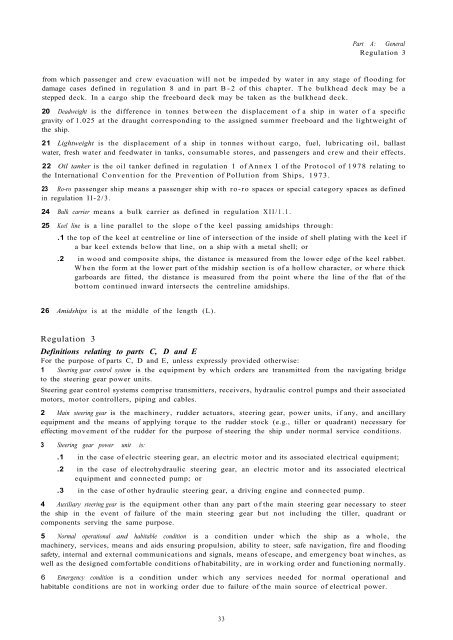Solas Consolidated Edition 2009.pdf
Solas Consolidated Edition 2009 for maritime
Solas Consolidated Edition 2009 for maritime
You also want an ePaper? Increase the reach of your titles
YUMPU automatically turns print PDFs into web optimized ePapers that Google loves.
Part A: General<br />
Regulation 3<br />
from which passenger and crew evacuation will not be impeded by water in any stage of flooding for<br />
damage cases defined in regulation 8 and in part B-2 of this chapter. The bulkhead deck may be a<br />
stepped deck. In a cargo ship the freeboard deck may be taken as the bulkhead deck.<br />
20 Deadweight is the difference in tonnes between the displacement of a ship in water of a specific<br />
gravity of 1.025 at the draught corresponding to the assigned summer freeboard and the lightweight of<br />
the ship.<br />
21 Lightweight is the displacement of a ship in tonnes without cargo, fuel, lubricating oil, ballast<br />
water, fresh water and feedwater in tanks, consumable stores, and passengers and crew and their effects.<br />
22 Oil tanker is the oil tanker defined in regulation 1 of Annex I of the Protocol of 1978 relating to<br />
the International Convention for the Prevention of Pollution from Ships, 1973.<br />
23 Ro-ro passenger ship means a passenger ship with ro-ro spaces or special category spaces as defined<br />
in regulation II-2/3.<br />
24 Bulk carrier means a bulk carrier as defined in regulation XII/1.1.<br />
25 Keel line is a line parallel to the slope of the keel passing amidships through:<br />
.1 the top of the keel at centreline or line of intersection of the inside of shell plating with the keel if<br />
a bar keel extends below that line, on a ship with a metal shell; or<br />
.2 in wood and composite ships, the distance is measured from the lower edge of the keel rabbet.<br />
When the form at the lower part of the midship section is of a hollow character, or where thick<br />
garboards are fitted, the distance is measured from the point where the line of the flat of the<br />
bottom continued inward intersects the centreline amidships.<br />
26 Amidships is at the middle of the length (L).<br />
Regulation 3<br />
Definitions relating to parts C, D and E<br />
For the purpose of parts C, D and E, unless expressly provided otherwise:<br />
1 Steering gear control system is the equipment by which orders are transmitted from the navigating bridge<br />
to the steering gear power units.<br />
Steering gear control systems comprise transmitters, receivers, hydraulic control pumps and their associated<br />
motors, motor controllers, piping and cables.<br />
2 Main steering gear is the machinery, rudder actuators, steering gear, power units, if any, and ancillary<br />
equipment and the means of applying torque to the rudder stock (e.g., tiller or quadrant) necessary for<br />
effecting movement of the rudder for the purpose of steering the ship under normal service conditions.<br />
3 Steering gear power unit is:<br />
.1 in the case of electric steering gear, an electric motor and its associated electrical equipment;<br />
.2 in the case of electrohydraulic steering gear, an electric motor and its associated electrical<br />
equipment and connected pump; or<br />
.3 in the case of other hydraulic steering gear, a driving engine and connected pump.<br />
4 Auxiliary steering gear is the equipment other than any part of the main steering gear necessary to steer<br />
the ship in the event of failure of the main steering gear but not including the tiller, quadrant or<br />
components serving the same purpose.<br />
5 Normal operational and habitable condition is a condition under which the ship as a whole, the<br />
machinery, services, means and aids ensuring propulsion, ability to steer, safe navigation, fire and flooding<br />
safety, internal and external communications and signals, means of escape, and emergency boat winches, as<br />
well as the designed comfortable conditions of habitability, are in working order and functioning normally.<br />
6 Emergency condition is a condition under which any services needed for normal operational and<br />
habitable conditions are not in working order due to failure of the main source of electrical power.<br />
33


